INSTITUT SUPERIEUR D'ANTHROPOLOGIE
INSTITUTE OF ANTHROPOLOGY
ONLINE COURSES / COURS A DISTANCE
SPRING TERM : APRIL 2014
REGISTER NOW
ROYAUME UNI –  Hébrides - An ancient Hebridean boat could be recovered from beneath the sands of a Benbecula beach this summer- more than 400 years after it sank. A 40ft Birlinn-style boat – is believed to be buried under the sand on Baleshare beach and could be the subject of an investigation by a team from Project SAMPHIRE (Scottish Atlantic Maritime Past: Heritage, Investigation, Research and Education). The marine archaeology project, funded by the Crown Estate, has been running for the last year and has already discovered more than 40 archaeological sites including wooden shipwrecks, cannons, ancient anchors, prehistoric fish traps and small fishing vessels around the north west of Scotland. John McCarthy, SAMPHIRE Project Manager of Wessex Archaeology Coastal and Marine said: “We have a number of sites to investigate in the Outer Hebrides including a birlinn-type boat in the intertidal sands at Benbecula, there are also reports of a possible B17 wreck on the seabed in the same area and a stone anchor found in Lewis.” Birlinn boats were extensively used in the islands and West Highlands from Middle Ages up to the 17th century, but there is currently no physical record of them in existence. Mr McCarthy added: “The Birlinn type site is very credible. If we can confirm it it will be the first physical evidence of this type and would be enormously exciting.” Rev Donald MacQuarrie from Fort William, who has links with Uist, has carried out much research on the unknown shipwrecks of Benbecula and says there have been no sightings of the Birlinn wreck since the late 19th century. Researchers from Project SAMPHIRE are also interested in another wreck site close by which is known about locally but not on the official database.
Hébrides - An ancient Hebridean boat could be recovered from beneath the sands of a Benbecula beach this summer- more than 400 years after it sank. A 40ft Birlinn-style boat – is believed to be buried under the sand on Baleshare beach and could be the subject of an investigation by a team from Project SAMPHIRE (Scottish Atlantic Maritime Past: Heritage, Investigation, Research and Education). The marine archaeology project, funded by the Crown Estate, has been running for the last year and has already discovered more than 40 archaeological sites including wooden shipwrecks, cannons, ancient anchors, prehistoric fish traps and small fishing vessels around the north west of Scotland. John McCarthy, SAMPHIRE Project Manager of Wessex Archaeology Coastal and Marine said: “We have a number of sites to investigate in the Outer Hebrides including a birlinn-type boat in the intertidal sands at Benbecula, there are also reports of a possible B17 wreck on the seabed in the same area and a stone anchor found in Lewis.” Birlinn boats were extensively used in the islands and West Highlands from Middle Ages up to the 17th century, but there is currently no physical record of them in existence. Mr McCarthy added: “The Birlinn type site is very credible. If we can confirm it it will be the first physical evidence of this type and would be enormously exciting.” Rev Donald MacQuarrie from Fort William, who has links with Uist, has carried out much research on the unknown shipwrecks of Benbecula and says there have been no sightings of the Birlinn wreck since the late 19th century. Researchers from Project SAMPHIRE are also interested in another wreck site close by which is known about locally but not on the official database.
http://www.stornowaygazette.co.uk/news/local-headlines/ancient-boat-may-be-unearthed-1-3288563
NEPAL - Panditpur - A team of archaeologists excavated substantial evidences suggesting that Panditpur of Banjariya VDC was the capital of the ancient state Koliya . The team made such a claim after finding materials dating back to the seventh century BC. The archaeologists have found ring wells, topaz, bangles, glasses, stones, and human statues dating back to the Kushand era. Former Deputy Director of the Department of Archaeology Tarananda Mishra claimed that the findings pointed to the fact that Panditpur was the capital of Koliya , also known as ‘Ramgram’ and is spread across 360,000 square kilometres. According to Mishra, the team excavated the foundations of boundary walls erected to protect the city which suggests that the site was the location of the administrative headquarters in Antonagar. The team has also found glasses belonging to the Mughal era suggesting that even the Mughal Kings might have visited the area. “The Kol trees and Kolin river located in the area provide basis for the existence of the state,” said Mshra. Koliya is believed to be among the sixteen states of ancient Jambudweep spread across Narayani river in the east, Rohini river of Rupandehi in the west, Pipliban in South India, and Chure hills in the north. “As the region was rife with tigers, the King Ram of Banaras saved a woman from attacks and later tied the knot with her. The King then settled in the area, built a pagoda known as Ramgram Stupa and established the city of Ramgram, which is known as Panditpur,” added Mishra.
http://www.ekantipur.com/2014/03/02/national/evidence-of-koliya-state-found-in-banjariya-excavation-site/386095.html
SOUDAN – 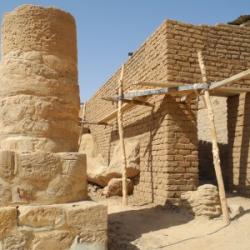 Jebel Barkal - The archaeological mission for the first phase of the restoration of the Temple of Mutt at Jebel Barkal, jointly carried out by the Italian Higher Institute for Conservation and Restoration in Rome (ISCR – Istituto Superiore per la Conservazione ed il Restauro) and the National Corporation of Antiquities and Museums (NCAM) with the support of the National Museum of the Sudan, and implemented within the framework of the “Qatar Sudan Archaeological Project” (QASAP), was successfully completed. The Temple of Mutt dates back to the 25th dynasty and was built during the seventh century B.C. by digging into the side of Jebel Barkal. This helped preserve the Temple and last year several short-term, preliminary missions were undertaken by the ISCR in order to assess its current conditions of preservation. The works carried out during this last mission have led to the restoration and conservation of the vestibule and the ensuing chamber which constitute the main body of the Temple of Mutt. Using both technical and chemical restoration techniques the joint ISCRand NCAM team carried out cleaning tests in order to analyze the frieze on the vestibule architrave and conducted further works for the general conservation of the Temple chambers which brought to light the striking colours of the well preserved hieroglyphs in the vestibule. At this stage, work on the second chamber has begun but most of the engravings have yet to be disclosed. Further excavations and research may also disclose further side chambers belonging to the Temple of Mutt. Under the supervision of the experts from the ISCR, the archaeological team erected a roofed structure enclosed by a wall to protect the temple chambers from the deteriorating action of external agents and to guarantee a stable micro-climate in the Temple. The structure was built using environmentally sustainable materials and adopting traditional Sudanese building techniques. It was also erected in the prospect of future missions which will continue the restoration work undertaken thus far.
Jebel Barkal - The archaeological mission for the first phase of the restoration of the Temple of Mutt at Jebel Barkal, jointly carried out by the Italian Higher Institute for Conservation and Restoration in Rome (ISCR – Istituto Superiore per la Conservazione ed il Restauro) and the National Corporation of Antiquities and Museums (NCAM) with the support of the National Museum of the Sudan, and implemented within the framework of the “Qatar Sudan Archaeological Project” (QASAP), was successfully completed. The Temple of Mutt dates back to the 25th dynasty and was built during the seventh century B.C. by digging into the side of Jebel Barkal. This helped preserve the Temple and last year several short-term, preliminary missions were undertaken by the ISCR in order to assess its current conditions of preservation. The works carried out during this last mission have led to the restoration and conservation of the vestibule and the ensuing chamber which constitute the main body of the Temple of Mutt. Using both technical and chemical restoration techniques the joint ISCRand NCAM team carried out cleaning tests in order to analyze the frieze on the vestibule architrave and conducted further works for the general conservation of the Temple chambers which brought to light the striking colours of the well preserved hieroglyphs in the vestibule. At this stage, work on the second chamber has begun but most of the engravings have yet to be disclosed. Further excavations and research may also disclose further side chambers belonging to the Temple of Mutt. Under the supervision of the experts from the ISCR, the archaeological team erected a roofed structure enclosed by a wall to protect the temple chambers from the deteriorating action of external agents and to guarantee a stable micro-climate in the Temple. The structure was built using environmentally sustainable materials and adopting traditional Sudanese building techniques. It was also erected in the prospect of future missions which will continue the restoration work undertaken thus far.
http://news.sudanvisiondaily.com/details.html?rsnpid=232796
IRLANDE – 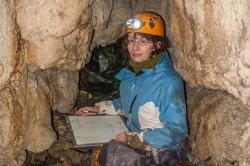 Knocknarea - Archaeologists at IT Sligo have found bones of a Stone Age child and an adult in a tiny cave high on Knocknarea mountain near the town.,,Radiocarbon dating has shown that they are some 5,500 years old, which makes them among the earliest human bones found in the county. The find represents important fresh evidence of Knocknarea’s Neolithic (Stone Age) links and a prehistoric practice known as “excarnation”. Researchers discovered a total of 13 small bones and bone fragments in an almost inaccessible cave last November. Three were from the child and 10 from the adult. They included foot bones and fragments of skull. The adult was aged 30 to 39 and the child of 4 to 6 years. It was not possible to establish gender.Dr Dowd says that the small number of bones and their small size suggest that the cave was an excarnation site. That involved a corpse being laid in a cave and, after decomposition, the dry bones being transferred elsewhere. Fragments were sometimes accidentally left behind. Dr Dowd, who led the rescue excavation, says Sligo - Leitrim is one of Ireland’s most important cave regions but only a few have been investigated archaeologically. Dr Dowd said: “When people died in prehistory, their corpses were sometimes laid out in caves. After one or two years, when the flesh and soft tissue had decomposed, the dry bones were collected and removed to another location. “We can imagine, therefore, that Stone Age people in Sligo between 5,000 and 5,500 years ago carried the corpses of their dead up the mountain. After an arduous climb, they then squeezed through the narrow cave entrance, and laid the dead person on the cave floor. “Sometime later, maybe after one or two years, people returned to the cave and collected the bones and took them to another location. Where they took them, we don’t know. But the monuments on the summit of Knocknarea are one likely possibility. All that was left behind in the cave were some small bones that had been overlooked”.
Knocknarea - Archaeologists at IT Sligo have found bones of a Stone Age child and an adult in a tiny cave high on Knocknarea mountain near the town.,,Radiocarbon dating has shown that they are some 5,500 years old, which makes them among the earliest human bones found in the county. The find represents important fresh evidence of Knocknarea’s Neolithic (Stone Age) links and a prehistoric practice known as “excarnation”. Researchers discovered a total of 13 small bones and bone fragments in an almost inaccessible cave last November. Three were from the child and 10 from the adult. They included foot bones and fragments of skull. The adult was aged 30 to 39 and the child of 4 to 6 years. It was not possible to establish gender.Dr Dowd says that the small number of bones and their small size suggest that the cave was an excarnation site. That involved a corpse being laid in a cave and, after decomposition, the dry bones being transferred elsewhere. Fragments were sometimes accidentally left behind. Dr Dowd, who led the rescue excavation, says Sligo - Leitrim is one of Ireland’s most important cave regions but only a few have been investigated archaeologically. Dr Dowd said: “When people died in prehistory, their corpses were sometimes laid out in caves. After one or two years, when the flesh and soft tissue had decomposed, the dry bones were collected and removed to another location. “We can imagine, therefore, that Stone Age people in Sligo between 5,000 and 5,500 years ago carried the corpses of their dead up the mountain. After an arduous climb, they then squeezed through the narrow cave entrance, and laid the dead person on the cave floor. “Sometime later, maybe after one or two years, people returned to the cave and collected the bones and took them to another location. Where they took them, we don’t know. But the monuments on the summit of Knocknarea are one likely possibility. All that was left behind in the cave were some small bones that had been overlooked”.
http://www.irishmirror.ie/news/irish-news/archaeologists-sligo-found-bones-stone-3193318
MYANMAR – Mandalay - The Fine Arts Department discovered historical traces of the Ayutthaya community in the Mandalay and Sagaing Regions in Myanmar, due to the continued cooperation in the archaeological conservation efforts of the two countries. Mr. Anek Sihamat, Director General of Thailand's Fine Arts Department, said Thai archaeologists and historians visited Mandalay and Sagaing Regions in Republic of the Union of Myanmar to study the history of the Ayutthaya people for the past four days and a discussion was held with Mr. Neo Min Tun, Deputy Director General of Department of Archaeology, Museums and Libraries of Myanmar.The two countries have exchanged cooperation: Thailand has sent archeological officials to Yangon and Bagan for academic purposes and coordinated with the University of Rangoon to bring Thai explorers and landscape architects to help improve the landscape of temples in Bagan. This discussion placed importance on historical data from the Yodia Community in Mandalay and from Thai and Myanmar literature. The Director General of the Fine Arts Department said that they found traces that could be linked to the history of Yodia community in the past, according to stories of artifacts of Ayutthaya descent in Myanmar, including murals similar to the Ayutthaya period found in Thein Daw Gyi Temple, Sagaing Region. Now, the temple has plastered part of murals on the chapel’s wall as it was affected by flooding, causing salt crust and crumbling cement. The Fine Arts Department of Thailand has asked the Department of Archaeology of Myanmar to allow to preserve the temple’s murals.
http://thainews.prd.go.th/centerweb/newsen/NewsDetail?NT01_NewsID=WNART5703020010001
PEROU – 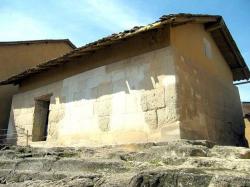 Cajamarca - One of Cajamarca’s most well-known historical attractions will soon be reopened to the public. According to El Comercio, the Cuarto del Rescate (“Ransom Room”) in which the Inca emperor Atahualpa was imprisoned by Francisco Pizarro and his conquistadores. Historical legend has it that Atahualpa, having been imprisoned and sentenced to death at the stake, offered to buy his freedom by filling the room with gold. The Ransom Room was closed due to heavy rains in the región as well as restoration work
Cajamarca - One of Cajamarca’s most well-known historical attractions will soon be reopened to the public. According to El Comercio, the Cuarto del Rescate (“Ransom Room”) in which the Inca emperor Atahualpa was imprisoned by Francisco Pizarro and his conquistadores. Historical legend has it that Atahualpa, having been imprisoned and sentenced to death at the stake, offered to buy his freedom by filling the room with gold. The Ransom Room was closed due to heavy rains in the región as well as restoration work
http://www.peruthisweek.com/news-peru-cajamarcas-ransom-room-to-be-reopened-to-tourists-102395
ITALIE – 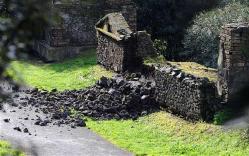
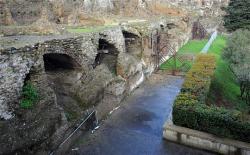 Pompéi- Italy's culture minister demanded explanations on Sunday after more collapses this weekend in the ancient Roman city of Pompeii raised concerns about the state of one of the world's most treasured archaeological sites.Officials said the wall of a tomb around 1.7 meters (5.5 feet) high and 3.5 meters long collapsed in the necropolis of Porta Nocera in the early hours of Sunday. That followed a smaller collapse on Saturday of part of an arch supporting the Temple of Venus. Heavy rains were cited as the immediate cause. The Temple of Venus is in an area of the site which was already closed to visitors, while access to the necropolis has been closed following the collapse of the wall.
Pompéi- Italy's culture minister demanded explanations on Sunday after more collapses this weekend in the ancient Roman city of Pompeii raised concerns about the state of one of the world's most treasured archaeological sites.Officials said the wall of a tomb around 1.7 meters (5.5 feet) high and 3.5 meters long collapsed in the necropolis of Porta Nocera in the early hours of Sunday. That followed a smaller collapse on Saturday of part of an arch supporting the Temple of Venus. Heavy rains were cited as the immediate cause. The Temple of Venus is in an area of the site which was already closed to visitors, while access to the necropolis has been closed following the collapse of the wall.
http://www.nbcnews.com/news/world/italy-investigating-new-collapses-ancient-pompeii-n42351
INDE –  Srirangam - The Archaeology Department, which commenced digging work near the 1,000-pillar mandapam at Srirangam Renganathaswamy temple unearthed a buried elephant statue and other treasures, including copper rings, coins and inscribed stones on Saturday.
Srirangam - The Archaeology Department, which commenced digging work near the 1,000-pillar mandapam at Srirangam Renganathaswamy temple unearthed a buried elephant statue and other treasures, including copper rings, coins and inscribed stones on Saturday.
http://www.newindianexpress.com/states/tamil_nadu/Jumbo-Statue-Unearthed-in-Srirangam-Temple/2014/03/02/article2085713.ece?#.UxNSn_l5PVQ